Cổng trục so với Cổng trục: 6 lợi ích chính giúp bạn chọn lựa phương án tốt nhất
Mục lục
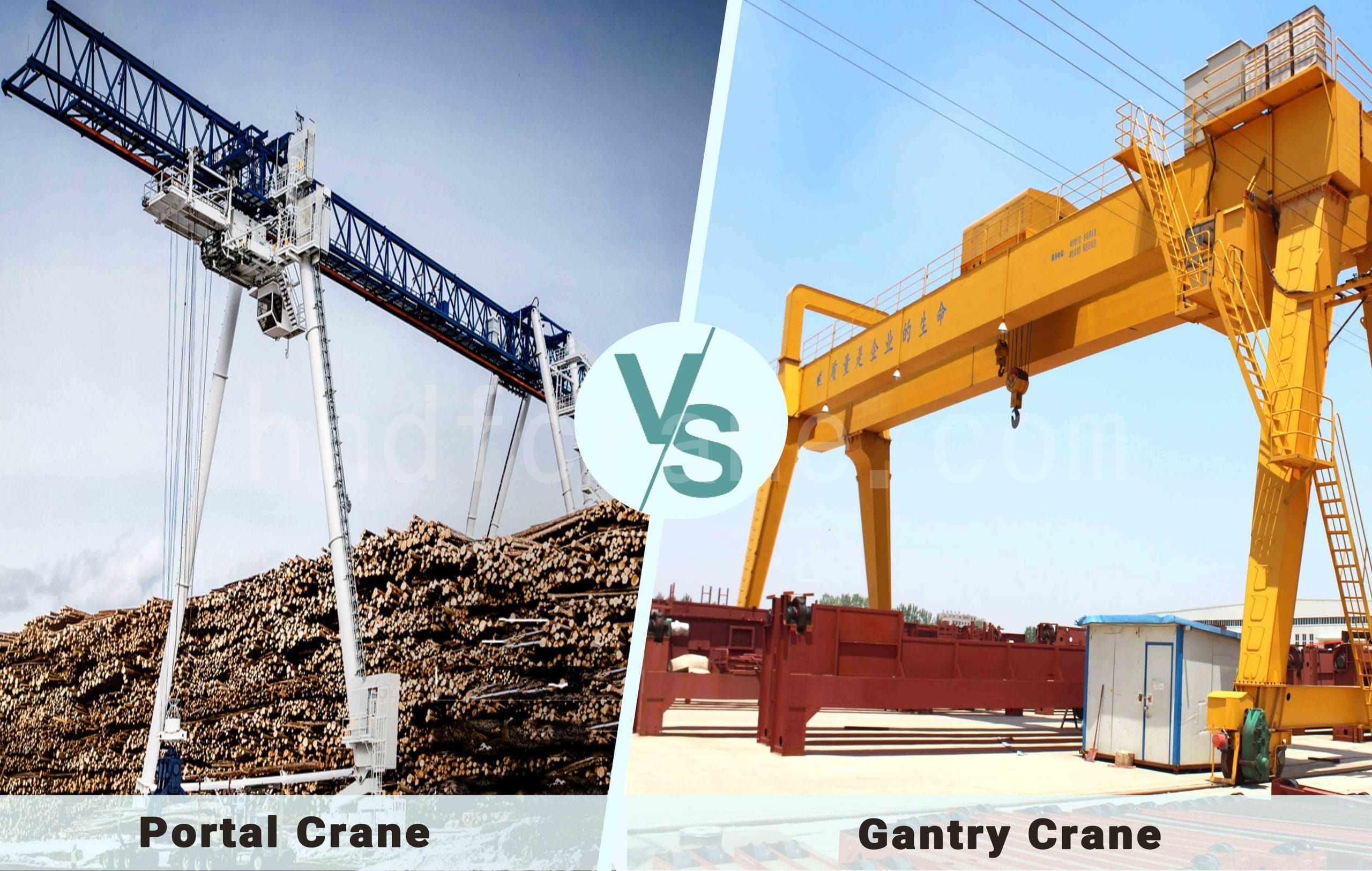
Khi lựa chọn thiết bị nâng, điều quan trọng là phải hiểu được sự khác biệt giữa các loại cần cẩu khác nhau. Cần cẩu cổng và cần cẩu cổng trục là hai loại phổ biến, mỗi loại có thiết kế và ứng dụng riêng. Nhưng chính xác thì điều gì khiến chúng khác biệt? Loại nào phù hợp hơn với nhu cầu của bạn? Trong bài viết này, chúng tôi sẽ khám phá các tính năng, ưu điểm và nhược điểm của cần cẩu cổng và cần cẩu cổng trục để giúp bạn đưa ra lựa chọn tốt nhất.
1. So sánh thông tin cơ bản
Định nghĩa cần cẩu cổng:
- Được thiết kế cho chặng đường dài, nó có thể xoay 360° theo quỹ đạo.
- Thường được sử dụng trong xếp gỗ, xếp bãi chứa đồ.
- Cẩu cổng đảm nhiệm việc dỡ và lưu trữ gỗ, cũng như việc nạp gỗ, tất cả trong một đơn vị. Nó có thể hoàn thành tới 40 lần lấy gỗ mỗi giờ (nếu khoảng cách di chuyển là tối thiểu). Theo cách này, nhiều xe tải có thể được dỡ hàng nếu cần thiết. Bạn có thể lấy một xe tải cọc thô cùng một lúc.
Ngành công nghiệp ứng dụng cần cẩu cổng:
- Đối với các ứng dụng và môi trường đòi hỏi khắt khe trong ngành Sản phẩm Lâm nghiệp, Liên phương thức, Sinh khối/Viên nén, Bê tông và nhiều ngành công nghiệp khác, cần trục cổng cần được chế tạo chắc chắn.
Ưu điểm của cần trục cổng:
- An toàn, thông minh và hiệu quả
- Năng lượng được tiết kiệm, công suất được tăng lên, phanh tái tạo được sử dụng và với mỗi chuyển động đi xuống hoặc giảm tốc, công suất được gửi trở lại lưới điện thay vì bị tiêu tán do sức cản. Với nhiều năng lượng hơn trở lại lưới điện, ít năng lượng cần được tạo ra hơn, tăng khả năng tiết kiệm chi phí.
- Buồng lái được thiết kế tiện dụng, khi người lái cảm thấy thoải mái, họ sẽ tập trung hơn vào nhiệm vụ đang làm, giảm nguy cơ tai nạn hoặc thương tích.
- Áp dụng công nghệ thông minh.
- Tăng diện tích lưu trữ.
- Cẩu cổng chỉ chiếm 4% diện tích bãi
- Cẩu trục cổng cũng cho phép lưu trữ theo chiều thẳng đứng lên tới 22,86m, giúp tăng đáng kể khả năng lưu trữ theo khối của kho.
- Cẩu trục được trang bị phanh bão và có thể hoạt động trong mọi điều kiện thời tiết, ngay cả ở những khu vực có gió mạnh.
- Cẩu trục có khả năng thích ứng với chuyển động dọc theo đường băng, cho phép cả cẩu trục và đường băng luôn trong tình trạng tốt trong thời gian dài.
Định nghĩa của cần trục cổng trục:
- Chiều dài thông thường là 35m, phù hợp cho mục đích sử dụng chung.
Ngành công nghiệp áp dụng cần cẩu giàn:
- Sân vận chuyển hàng hóa, công trường xây dựng, ga trung chuyển đường sắt
- Nhà máy đóng tàu và cảng
- Nhà máy dầm
Ưu điểm của cần trục cổng trục:
- Tỷ lệ sử dụng cao, sử dụng rộng rãi, khả năng thích ứng mạnh, tính linh hoạt cao, là thiết bị nâng hạ bằng cổng thông tin được sử dụng phổ biến nhất, trọng lượng định mức từ 5 tấn-500 tấn.
- Cẩu trục chiếm 25% diện tích bãi.
Cổng cần cẩu


Cần trục cổng trục


2.So sánh phân loại
Cổng cần cẩu
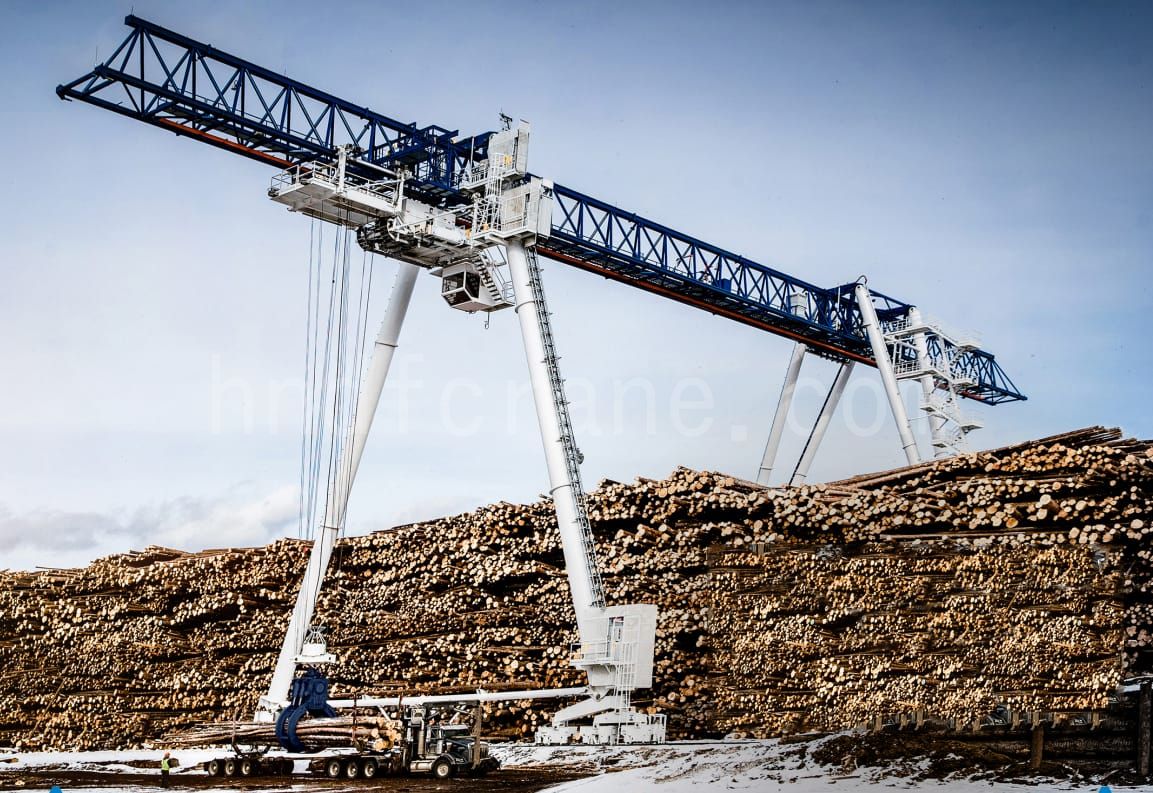
Cẩu cổng trục thẳng
- Phổ biến nhất và tối ưu nhất cho việc mở rộng đường băng trong tương lai và mở rộng không gian lưu trữ.
- Cung cấp lưu lượng xe tải tối ưu và lưu trữ tối đa.
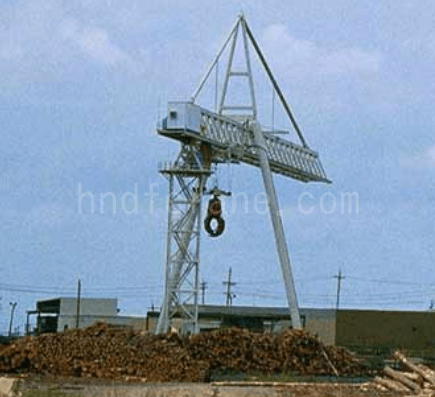
Cẩu cổng xoay
- Thường phù hợp với những nơi mà cần cẩu đường thẳng không thể đi qua.
- Cung cấp không gian lưu trữ bên trong và bên ngoài đường ray.
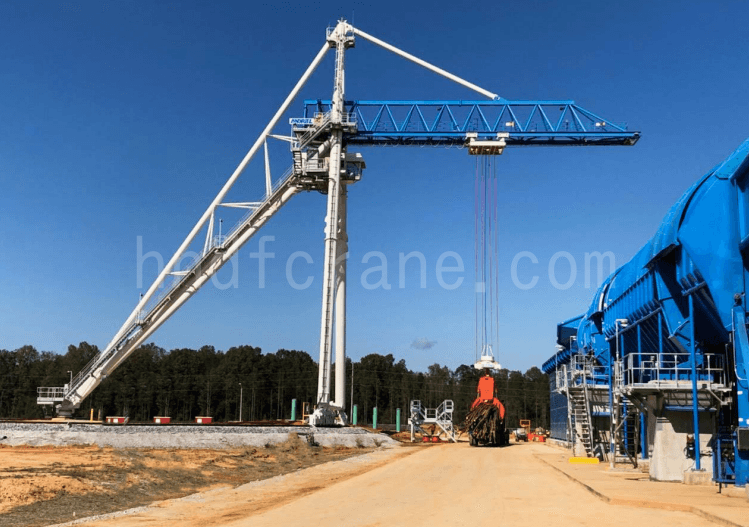
Cần cẩu gỗ
- Cần cẩu xoay quanh giá đỡ trung tâm ổ trục. Hai chân trước lớn di chuyển trên đường ray tròn, cho phép cần cẩu xếp chồng các khúc gỗ xung quanh để lưu trữ cho đến khi các khúc gỗ cần được đưa vào phễu.
Cần trục cổng trục
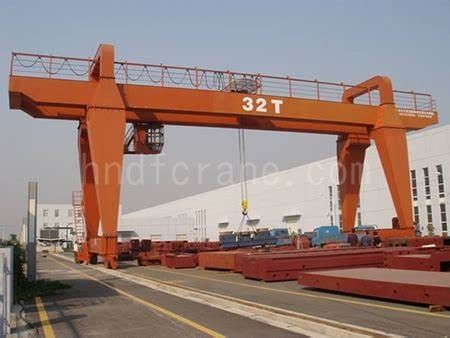
Khung cửa khung nhô ra ngoài đôi
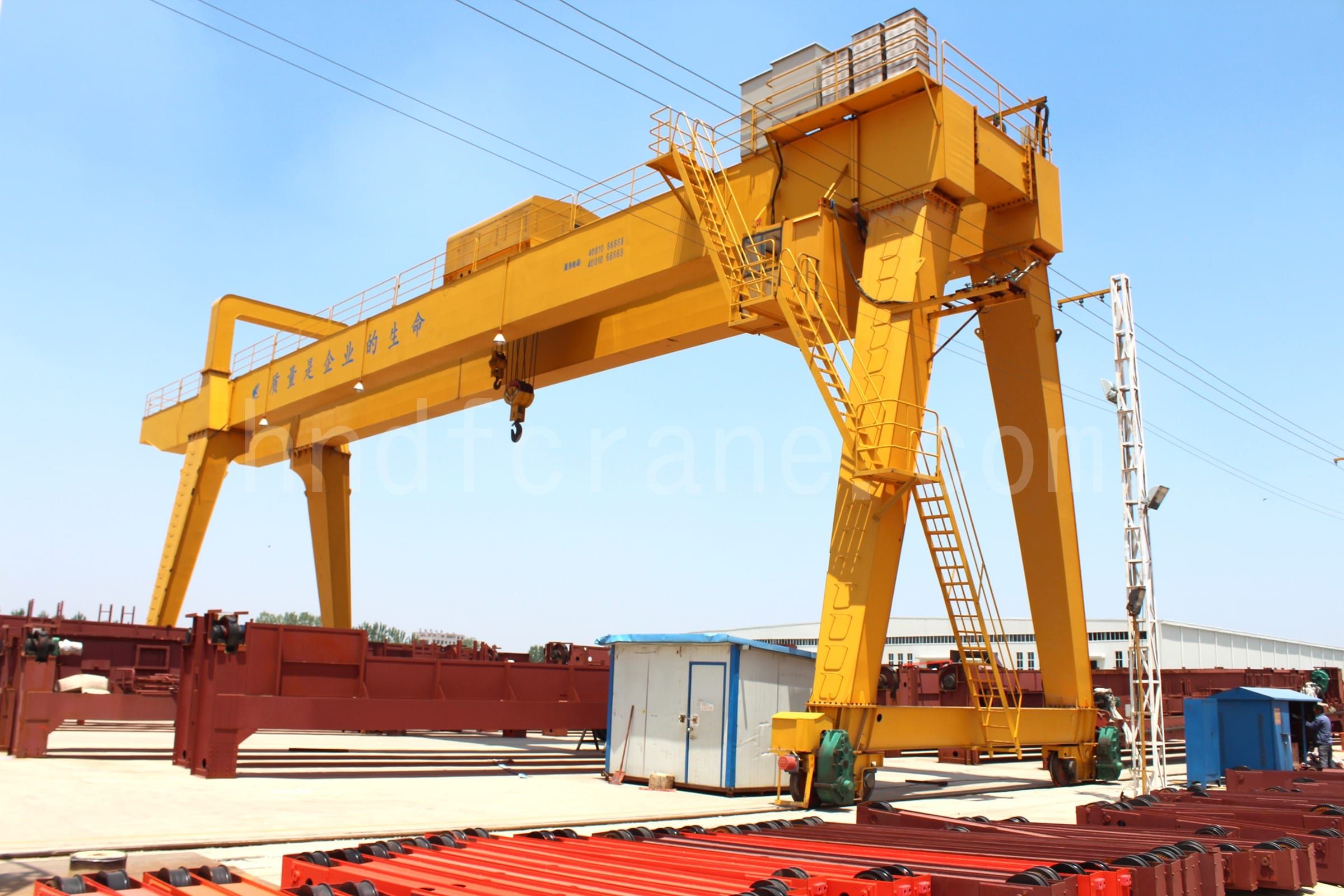
Khung cửa một bên với khung nhô ra ngoài
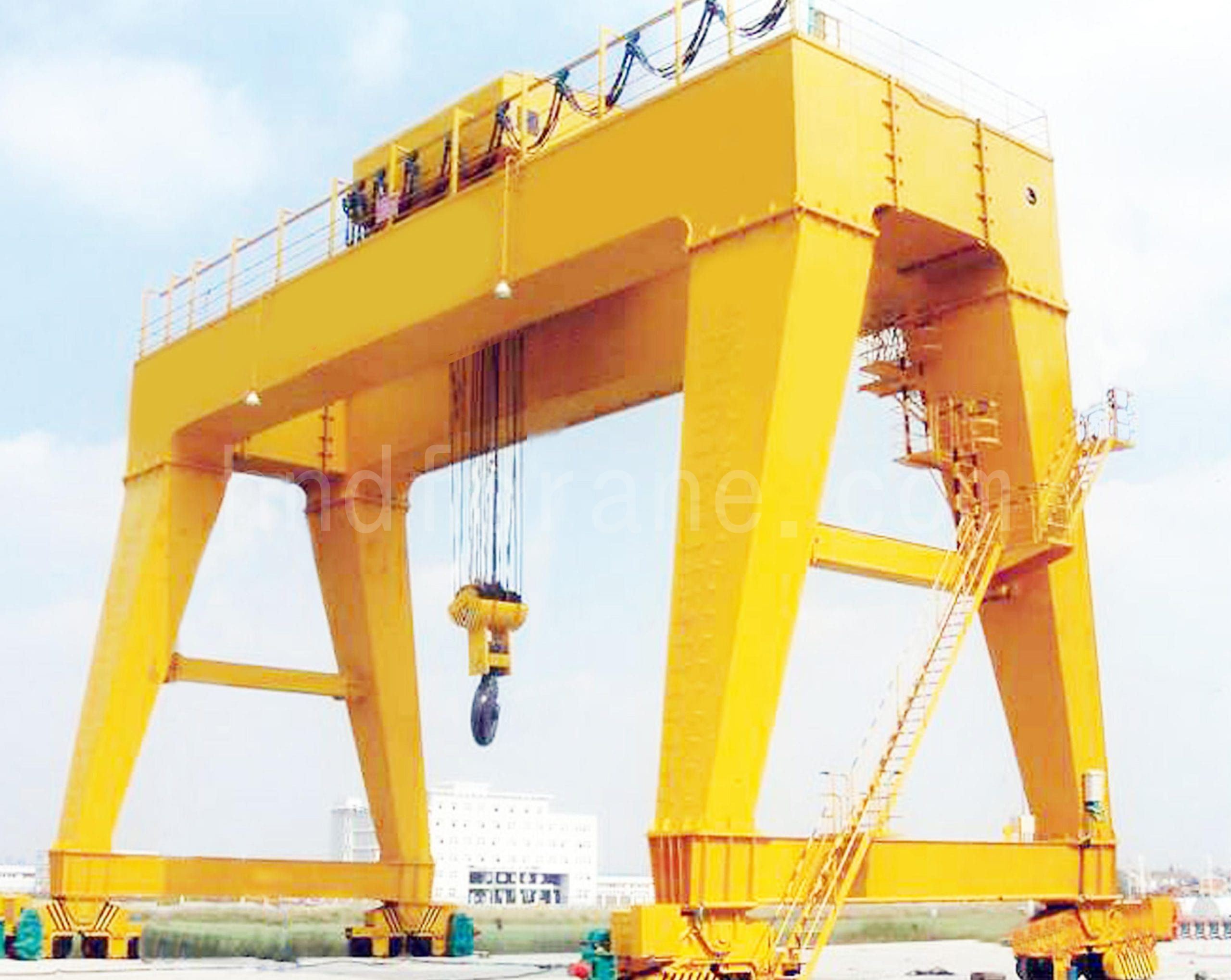
Không có khung nhô ra ngoài
Truyền thống cần trục của giàn cần cẩu có thể áp dụng rộng rãi, có nhiều hình thức và phân loại, trong danh mục này, ba loại trên cũng có thể được chế tạo thành cần trục giàn, cần trục Dafang có thể tùy chỉnh các sản phẩm bạn cần một đến một. Bạn có thể liên hệ với chúng tôi nếu bạn cần bất cứ điều gì.
3. So sánh chi phí
Chi phí đầu tư ban đầu cho cần trục Poral thường thấp hơn so với cần trục cổng truyền thống vì cần trục cổng nhẹ hơn và có thể hoạt động trên các đường ray không yêu cầu độ song song và độ thẳng tương tự.
Cần cẩu cổng chỉ cần đường ray mặt đất tiêu chuẩn được đặt trên tà vẹt đường sắt trên nền sỏi hoặc nền bê tông đơn giản. Chúng có thể thích ứng với địa hình không ổn định, hạn chế nhu cầu về công việc bề mặt tốn kém trong khi cho phép cần cẩu hoạt động hết công suất ở bất cứ nơi nào có thể đặt đường ray. Kiểu lắp đặt này tiết kiệm rất nhiều tiền so với nền móng sâu và nặng của cần cẩu cổng trục truyền thống.
Tiết kiệm chi phí vận hành, cần trục cổng kết hợp việc dỡ hàng, vận chuyển và xếp chồng vật liệu trong một hoạt động hiệu quả. Sự kết hợp của các hoạt động này làm giảm nhu cầu về thiết bị, bảo trì và nhân sự, giảm đáng kể chi phí vận hành so với các bãi sử dụng cần trục cổng.
Cần cẩu Poral có động cơ và hệ thống điều khiển tiết kiệm năng lượng được thiết kế để hoạt động đáng tin cậy trong thời gian dài mà không cần bảo trì lớn và các chi phí liên quan.
4. Sự khác biệt giữa kết cấu dầm hộp và kết cấu giàn hoa (giàn)
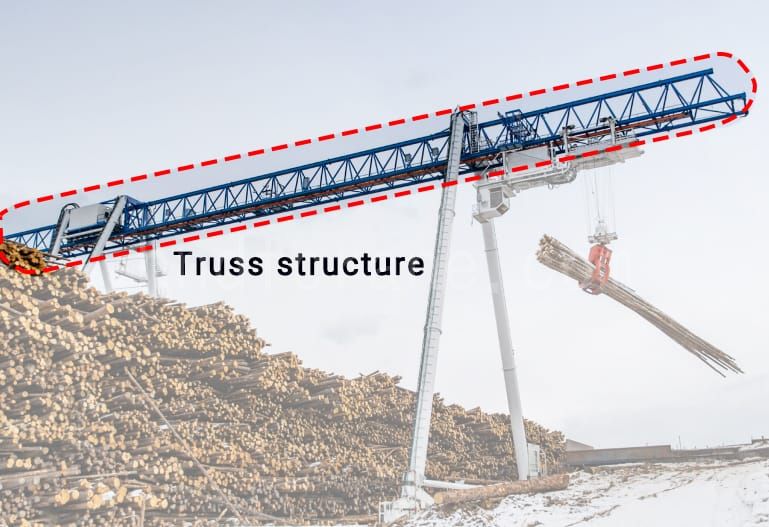
- Thiết kế dạng lưới này có hiệu quả về mặt chi phí khi so sánh với kết cấu dầm hộp. Thiết kế mở cũng cho phép kiểm tra dễ dàng các mối hàn quan trọng trong suốt vòng đời của cần cẩu.
- Dầm giàn là dầm chính có vật liệu đối diện (như thép hình, thép góc, thép hình chữ T), có thể điều chỉnh góc và chiều dài, thuận lợi hơn cho việc xử lý các vật thể không đều.
- Cấu trúc này có thể giảm diện tích đón gió của cần cẩu, sức cản gió mạnh, thích hợp sử dụng ở những nơi thoáng gió.
- Thiết kế mở cũng cho phép dễ dàng kiểm tra các mối hàn quan trọng trong suốt thời gian sử dụng của cần cẩu.
- Do kết cấu dầm chính có thiết kế mở nên việc đại tu và bảo dưỡng tương đối đơn giản, đặc biệt đối với một số kết cấu quá nhỏ, có thể quan sát tốt hơn và giảm vùng mù trong quá trình bảo dưỡng.
- Kết cấu dầm chính có hệ thống chân đỡ tự do hơn, khả năng thích ứng và linh hoạt tốt hơn.
- Kết cấu dầm chính có giàn dễ tháo lắp hơn. Do có kết cấu chân có thể tháo rời.
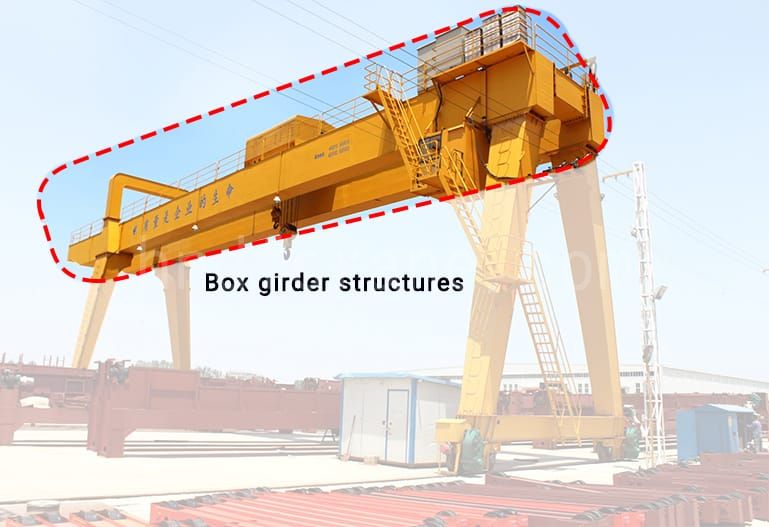
- Cầu trục dạng cổng hộp có sức cản gió yếu, tự tải và giá thành cao hơn loại kết cấu giàn.
- Dầm hộp cần trục cổng trục được làm bằng tấm thép hàn vào kết cấu hộp.
- Cầu trục dạng hộp có kết cấu hoàn toàn khép kín, không thể trực tiếp quan sát và kiểm tra cấu trúc cơ khí bên trong.
- Cầu trục dạng hộp có cấu trúc ổn định tốt, có thể duy trì tốt hơn tính an toàn và độ tin cậy của hoạt động thiết bị.
- Cầu trục có cấu trúc hộp có tuổi thọ cao hơn do khả năng chống mỏi tốt.
- Cần trục cổng có kết cấu dạng hộp phải có một số cơ sở vật chất và điều kiện nhất định tại nơi sử dụng trước khi có thể tháo dỡ.
Tài liệu tham khảo: công ty cung cấp dịch vụ hỗ trợ
5. Sự khác biệt giữa chân linh hoạt và chân bản lề
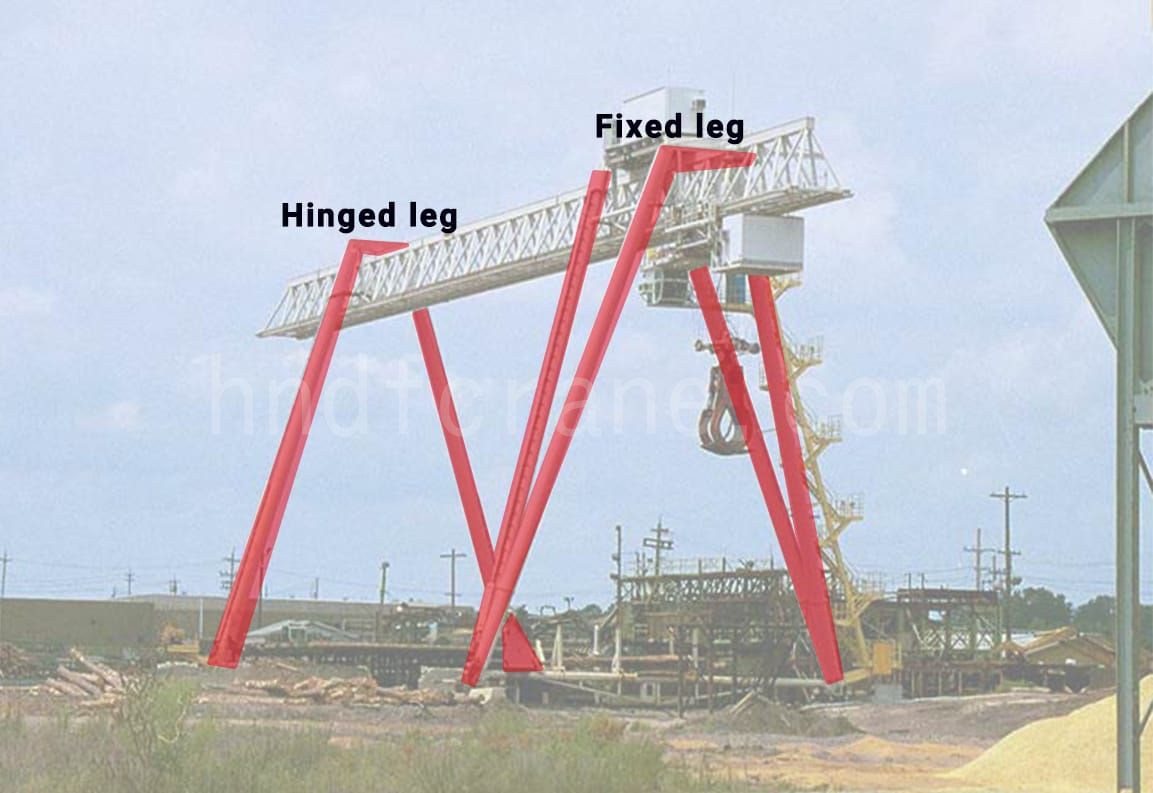
- Cẩu cổng được thiết kế để có tính linh hoạt tối đa, giảm thiểu việc bảo trì kết cấu và đường ray xuống mức tối thiểu. Cẩu cổng được thiết kế để có tính linh hoạt tối đa, giảm thiểu việc bảo trì kết cấu và đường ray xuống mức tối thiểu.
- Các chân linh hoạt có mức độ tự do nhất định và được gắn bản lề khi kết nối với dầm chính.
- Các chân linh hoạt được hàn bằng hai ống thép có độ dày thành bằng nhau, phần đáy được kết nối với dầm dưới theo cấu trúc hình tam giác có độ ổn định tốt.
- Do các chân linh hoạt có thể di chuyển dọc theo đường ray vành đai của cần trục nên nó phù hợp với một số nơi cần cần trục thực hiện công việc cong.
- Nó bao gồm nhiều hơn vào nền móng và có thể áp dụng trên mặt đất không bằng phẳng.
- Chân linh hoạt cũng thích hợp cho các hoạt động đòi hỏi cần cẩu phải tiếp cận hoặc di chuyển qua các cấu trúc khác.
- Sức chứa yếu.
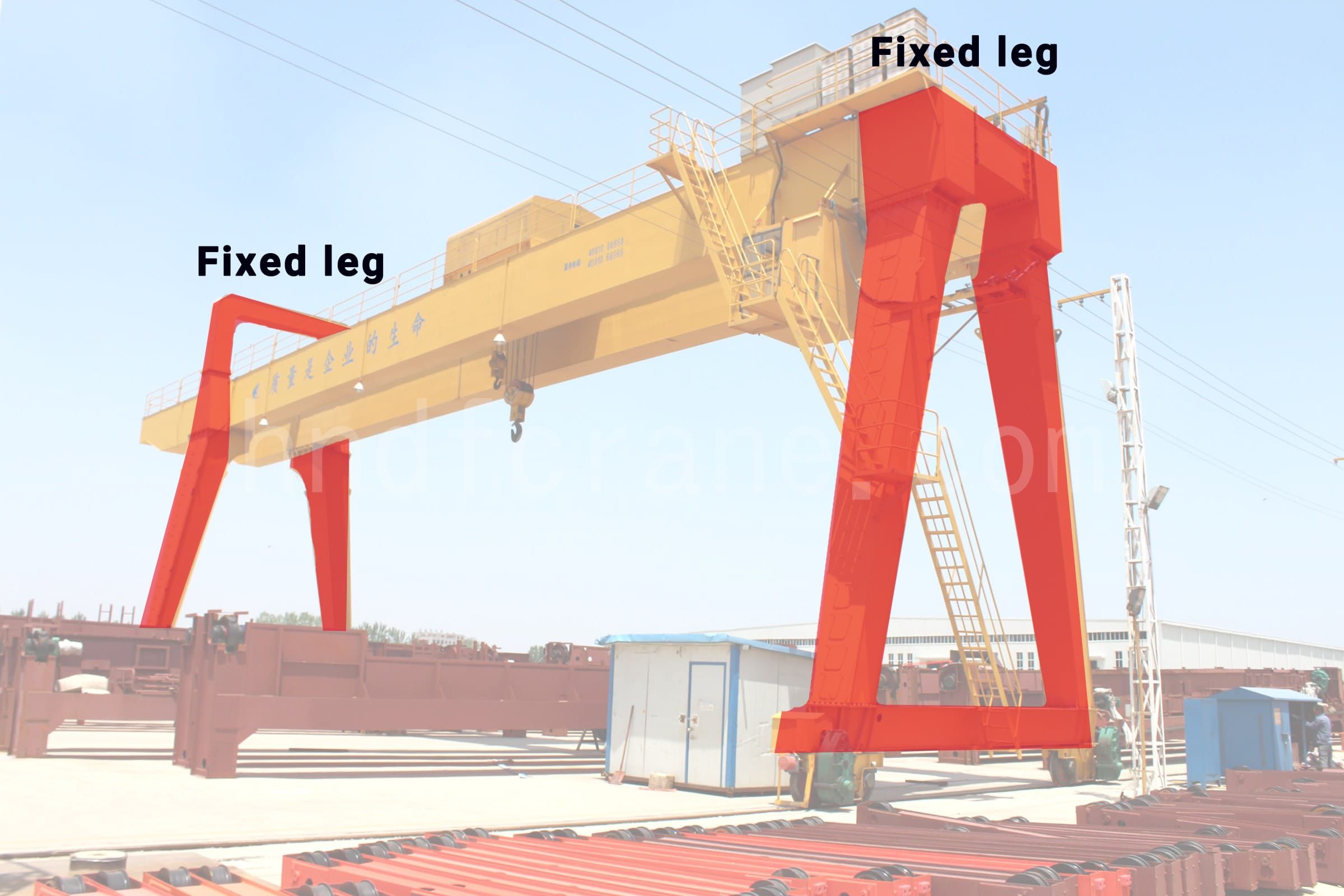
- Các chân cứng được bu lông khi kết nối với dầm chính, do đó mức độ tự do bị hạn chế hoàn toàn
- Chân cứng cũng là cấu trúc dạng hộp và kích thước mặt cắt giảm dần từ trên xuống dưới.
- Nhờ khả năng chịu lực lớn và độ ổn định của chân cứng nên sản phẩm phù hợp với một số nơi yêu cầu cần cẩu thực hiện các hoạt động có tải trọng lớn và độ chính xác cao.
- Các chân cứng chịu được nhiều thiết bị của cần cẩu như phòng điều khiển điện, điện trở, v.v. Để nhân viên dễ dàng tiếp cận buồng lái hoặc dầm chính, một thang cuốn được lắp đặt giữa hai chân cứng.
- Chân cứng cũng phù hợp với nhiều hoạt động khác nhau, chẳng hạn như khai thác và xử lý trong các mỏ lộ thiên, bãi chứa hàng lớn, v.v.
- Chi phí bảo trì cao và yêu cầu cao đối với nền móng
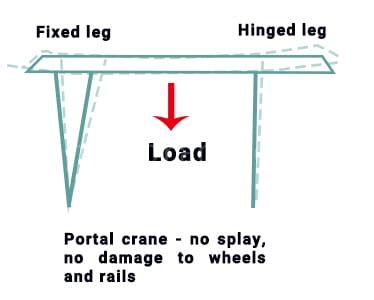
- Cẩu cổng sử dụng thiết kế chân cứng và linh hoạt. Thiết kế cứng và linh hoạt này cho phép chân xoay tự do so với dầm chính, có thể giảm hiện tượng tập trung ứng suất do hoạt động lệch của cẩu cổng hoặc sự giãn nở nhiệt của dầm chính gây ra
- Cần trục cổng ở cả hai bên thường sử dụng dạng một chân cứng và một chân mềm. Một chân của cần trục cổng được gắn bản lề với cầu, do đó toàn bộ cổng trục là một hệ thống xác định tĩnh, loại bỏ lực đẩy ngang của toa xe vào đường ray do tải trọng nâng gây ra. Đồng thời, trạng thái ứng suất của hệ thống cổng trục xác định tĩnh tương đối rõ ràng khi toa xe chạy lệch.
- Tuy nhiên, loại kết cấu này có độ cứng kết cấu thấp, đặc tính động kém, chuyển vị ngang lớn do dầm chính tạo ra trong quá trình nâng và độ cứng động theo phương thẳng đứng theo phương ngang không đủ.

- Xe đẩy đầy tải của cần trục Gantry nằm ở giữa dầm chính. Do xe đẩy dưới chân hai bên không đồng bộ nên khung Gantry sẽ bị xoắn, xảy ra tai nạn nghiêm trọng, hậu quả rất thảm khốc.
- Các kết cấu cứng, chẳng hạn như cần trục dầm hộp, cực kỳ nhạy cảm với tải trọng bên do độ lệch của chân, dẫn đến mòn vành bánh xe và cuối cùng là phải thay thế xích.
- Cần trục cổng trục sử dụng kết cấu chân đế đôi cứng có độ cứng cao và đặc tính động tốt. Tuy nhiên, do kết cấu tĩnh không xác định nên phần dưới của chân sẽ lệch ra ngoài khi chịu tải nâng. Nếu độ lệch vượt quá khe hở giữa bánh xe và đường ray (trong trường hợp bình thường: Khe hở giữa bánh xe và đường ray không vượt quá 15mm, cần trục sẽ không xảy ra sự cố nguy hiểm), thì xe tải sẽ tạo ra lực đẩy ngang lớn trên đường ray, lực này không có lợi cho hoạt động của xe tải và sẽ gây ra hiện tượng gặm đường ray. Đồng thời, có yêu cầu cao hơn đối với việc cố định đường ray, đặc biệt là khi nhịp lớn, ngay cả trạng thái không tải cũng sẽ xuất hiện hiện tượng gặm đường ray.
6. So sánh chân đế cần cẩu

- Hình ảnh cho thấy sơ đồ mặt cắt ngang của nền đường băng theo kiểu "tie and ballast", được sử dụng để hỗ trợ cần cẩu. Nền được xây dựng bằng nhiều lớp, mỗi lớp có mục đích riêng biệt để đảm bảo tính ổn định, độ bền và thoát nước thích hợp. Sau đây là phân tích các lớp từ dưới lên trên:
- Đá thoát nước: Đây là lớp dưới cùng, bao gồm các loại đá được thiết kế để thoát nước thích hợp. Lớp này đảm bảo nước không tích tụ dưới móng, nếu không có thể dẫn đến suy yếu hoặc xói mòn.
- Subballast nén chặt: Phía trên lớp đá thoát nước là lớp đá dăm nén chặt. Lớp này thường được làm bằng vật liệu mịn hơn và được nén chặt để tạo thành lớp nền ổn định cho các lớp trên. Nó giúp phân bổ tải trọng từ các lớp trên đều hơn và tăng thêm khả năng thoát nước.
- Lưới địa kỹ thuật: Một lưới địa kỹ thuật được đặt phía trên lớp đá dăm nén chặt. Lưới địa kỹ thuật là vật liệu địa tổng hợp được sử dụng để gia cố đất, cung cấp thêm độ ổn định và sức mạnh cho nền móng. Chúng ngăn chặn sự di chuyển của lớp đá dăm và tăng khả năng chịu tải tổng thể của nền móng.
- Ballast trên:Lớp này bao gồm các loại đá hoặc đá dăm lớn hơn tạo thành một lớp nền vững chắc cho các thanh giằng bê tông. Đá dăm đóng vai trò quan trọng trong việc phân phối tải trọng từ đường ray và thanh giằng và duy trì sự thẳng hàng của đường ray bằng cách chống lại các lực ngang, dọc và thẳng đứng.
- Bê tông Tie: Các thanh giằng bê tông (hoặc tà vẹt) được đặt trên lớp đá dăm phía trên. Các thanh giằng này là thành phần quan trọng giữ cho ray cố định, duy trì khổ đường ray và sự thẳng hàng của đường ray.
- đường sắt: Cuối cùng, đường ray được đặt lên trên các thanh giằng bê tông. Đường ray là đường ray mà cần cẩu di chuyển. Chúng được gắn chặt vào các thanh giằng bê tông bằng kẹp hoặc các vật cố định khác để giữ chúng cố định tại chỗ.
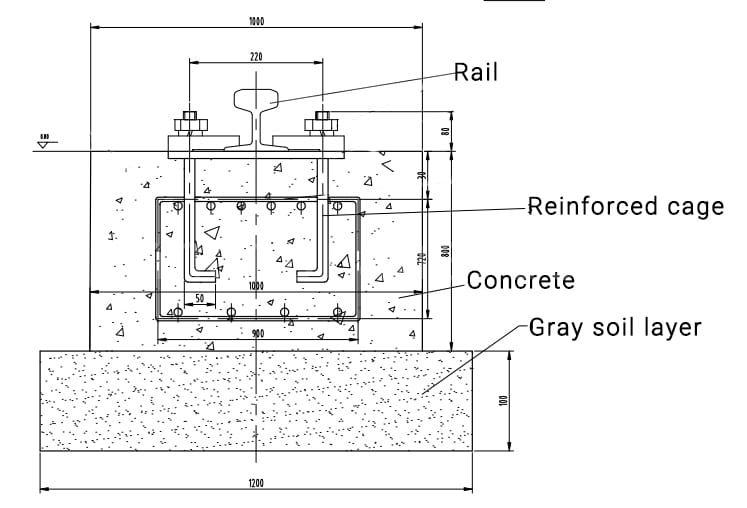
- Hình ảnh được cung cấp cho thấy bản vẽ kỹ thuật về thiết kế móng cho hệ thống đường ray xe lửa. Bản vẽ nêu chi tiết mặt cắt ngang của móng, làm nổi bật các lớp và thành phần được sử dụng trong quá trình xây dựng. Sau đây là phân tích các thành phần được hiển thị trong bản vẽ:
- đường sắt:Đây là thành phần trên cùng của móng. Đường ray là đường ray kim loại mà tàu hỏa hoặc cần cẩu di chuyển. Đường ray thường được làm bằng thép cường độ cao và được cố định vào móng bê tông bằng bu lông và chốt. Đường ray được hiển thị được gắn trực tiếp vào bề mặt bê tông.
- Lồng gia cố:Bên dưới thanh ray, được nhúng trong bê tông, là một lồng thép gia cường. Lồng này bao gồm các thanh thép được sắp xếp theo kiểu lưới, cung cấp độ bền kéo và tăng cường tính toàn vẹn của kết cấu bê tông. Lồng gia cường ngăn ngừa nứt và phân phối tải đều hơn trên toàn bộ bê tông.
- Bê tông:Lớp bê tông tạo thành phần chính của móng. Đây là khối bê tông cốt thép vững chắc hỗ trợ ray và hấp thụ tải trọng truyền từ ray. Bê tông được đổ lên lồng thép cốt thép và được thiết kế để chịu lực nén đáng kể. Bản vẽ chỉ ra độ dày 900 mm cho móng bê tông, mang lại sự ổn định và hỗ trợ đáng kể.
- Lớp đất xám:Lớp đất xám là lớp nền mà toàn bộ móng nằm trên đó. Lớp này có thể bao gồm đất nén chặt hoặc nền đất đã chuẩn bị sẵn tạo thành lớp nền ổn định cho móng bê tông. Bản vẽ cho thấy lớp này có độ dày 100 mm, cho thấy lớp này được nén chặt và đóng vai trò là lớp nền để phân phối tải trọng từ móng bê tông.
Cần cẩu cổng chỉ cần đường ray mặt đất tiêu chuẩn được đặt trên tà vẹt đường sắt trên nền sỏi hoặc nền bê tông đơn giản. Chúng có thể thích ứng với địa hình không ổn định, hạn chế nhu cầu về công việc bề mặt tốn kém trong khi cho phép cần cẩu hoạt động hết công suất ở bất cứ nơi nào có thể đặt đường ray. Kiểu lắp đặt này tiết kiệm đáng kể so với kết cấu thép của cần cẩu cổng hoặc nền móng sâu và nặng của cần cẩu cổng truyền thống.
Tóm lại
Khi bạn cân nhắc đến việc tiết kiệm diện tích bãi, giảm nhân công, thời gian quay vòng xe tải nhanh hơn, ít thiết bị hơn, giảm bảo trì, loại bỏ việc sử dụng dầu nhiên liệu và ô nhiễm mặt đất, thì Cẩu cổng chính là giải pháp THÔNG MINH.
Tóm lại, bằng cách hiểu sâu sắc về sự khác biệt giữa cần trục cổng và cần trục cổng trục ở năm khía cạnh: phân loại, chi phí, loại hộp và giàn, chân cứng và chân mềm, và nền móng, chúng ta có thể đánh giá tốt hơn những ưu điểm của chúng trong các tình huống ứng dụng khác nhau. Cần trục cổng trục, với tính linh hoạt và khả năng thích ứng cao, phù hợp để sử dụng trong các môi trường có không gian hạn chế hoặc yêu cầu xử lý đa dạng, trong khi cần trục cổng trục, với khả năng chịu tải và tính linh hoạt vượt trội, lý tưởng cho các nhiệm vụ nâng vật nặng. Khi đưa ra quyết định cuối cùng, bạn có thể chọn thiết bị nâng phù hợp nhất với mình dựa trên nhu cầu vận hành cụ thể, ngân sách và điều kiện công trường của bạn.
Cho dù bạn đang tìm kiếm khả năng kiểm soát chính xác và tính linh hoạt, hay tính ổn định và hiệu quả về chi phí, đội ngũ chuyên gia của Dafang Crane có thể cung cấp cho bạn lời khuyên và giải pháp được cá nhân hóa để đảm bảo bạn tối đa hóa lợi nhuận đầu tư của mình. Hãy liên hệ với chúng tôi và để chúng tôi giúp bạn tìm ra giải pháp cần cẩu hoàn hảo để cải thiện hiệu quả hoạt động của bạn!
gửi yêu cầu của bạn
- E-mail: sales@hndfcrane.com
- WhatsApp: +86-191 3738 6654
- ĐT: +86-373-581 8299
- Fax: +86-373-215 7000
- Địa chỉ: Khu công nghiệp Changnao, thành phố Tân Hương, tỉnh Hà Nam, Trung Quốc










































































